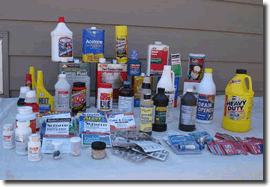About Meth
- What is Meth
- Effects of Meth
- Meth Users
- Signs of Meth use
- Meth Addiction
- Meth Withdrawal
- Meth Overdose
- Meth Addiction Treatment
- Facts About Meth
- Meth Statistics
- Meth Labs
- Meth Ingredients
- Crystal Meth
- Cost of Meth
- Meth Side Effects
- Smoking Meth
- Injecting Meth
- Snorting Meth
- What Does Meth Smell Like
- What Does Meth Look Like
- Meth Mouth
- Meth Sores
- Meth Pictures
- Meth User Pictures

Meth Ingredients
 Specific meth ingredients vary with each meth cook but there are some that are generally the same for most. Many of the chemicals can be found in common household items such as lantern fuel, cleaners, acetone, muriatic acid, and diet pills. The processing required to make methamphetamine from precursor substances is easier and more accessible than ever. There are literally thousands of recipes and information about making meth on the Internet. An investment of a few hundred dollars in over-the-counter medications and chemicals can produce thousands of dollars worth of methamphetamine. The drug can be made in a makeshift "lab" that can fit into a suit case. The average meth "cook" annually teaches ten other people how to make the drug.
Specific meth ingredients vary with each meth cook but there are some that are generally the same for most. Many of the chemicals can be found in common household items such as lantern fuel, cleaners, acetone, muriatic acid, and diet pills. The processing required to make methamphetamine from precursor substances is easier and more accessible than ever. There are literally thousands of recipes and information about making meth on the Internet. An investment of a few hundred dollars in over-the-counter medications and chemicals can produce thousands of dollars worth of methamphetamine. The drug can be made in a makeshift "lab" that can fit into a suit case. The average meth "cook" annually teaches ten other people how to make the drug.
As mentioned above, household products contain most of the necessary meth ingredients to complete the manufacturing process. Certain brands of drain cleaner, for instance, have a high concentration of sulfuric acid. When mixed with table or rock salt, hydrogen chloride gas is produced for use in the final stage of methamphetamine production. The hydrogen chloride gas procedure as well as other procedures are extremely dangerous and can cause death or serious injury not only to the individuals making the methamphetamine, but to others who may be living in an adjoining house or apartment.
Meth ingredients are toxic, and the lab operators routinely dump waste into streams, rivers, fields, and sewage systems. The chemical vapors produced during cooking permeate the walls and carpets of houses and buildings, making them uninhabitable. Cleaning up these sites requires specialized training and costs an average of $2,000-$4,000 per site in funds that come out of the already-strained budgets of state and local police.
There are many different methods for producing methamphetamine. Each method has its own inherent dangers. Many of the chemicals used are caustic or corrosive, and some of the processes create noxious and harmful fumes. One variation is called the "Nazi method" because it supposedly mirrors a meth-making procedure followed by the Germans during World War II. Instead of hydriodic acid as one of the meth ingredients, the Nazi method uses anhydrous ammonia, a chemical found in fertilizer and often stored in large tanks on farms. Meth makers sometimes are known to steal the product in the middle of the night and briefly set up shop near the tank. Anhydrous ammonia can produce a poisonous gas if its liquid form is released into the air. Another method is more earthy. In some areas, so much meth by-product has been dumped into the soil that cooks are excavating hundreds of cubic yards of earth from the sites to process the dirt and extract the chemicals to make meth.
Ever wonder why so many people find crystal meth so addictive? After reading about the list of meth ingredients, you may find the phenomenon even more puzzling:
Meth Ingredients: Chemicals
- Ephedrine (Cold Tablets): The use of ephedrine in making methamphetamines is the main reason why many sinus medications like Sudafed, with active ingredient of ephedrine, are under lock and key at grocery stores and pharmacies now. Ephedrine causes the brain to release dopamine, a chemical naturally produced by the body that evokes feelings of elation on the same level as sex, food, and other rewards necessary for species survival. Ephedrine’s effect of releasing dopamine is thought to be the reason why people become so addicted to meth. The problem is that by artificially creating dopamine chemically, meth users eventually lose the ability to feel happiness at all.
- Pseudoephedrine (Cold Tablets)
- Acetone
- Alcohol (Isopropyl or Rubbing)
- Toluene (Brake Cleaner)
- Ether (Engine Starter): Once called “sweet vitriol” because of its hypnotic effect, this highly flammable substance is used as an anesthetic agent - especially in third world countries where more expensive anesthesia is not available. While inhaling the compound, patients could undergo complete surgical procedures while otherwise awake without feeling pain or concern.
- Sulfuric Acid (Drain Cleaner)
- Methanol/Alcohol (Gasoline Additives)
- Salt (Table/Rock)
- Lithium (Batteries)
- Anhydrous Ammonia (Farm Fertilizer): This substance, used in chemical fertilizer and as a commercial refrigerant, has extremely destructive effects on humans. Breathing the vapor can cause severe irritation and permanent damage to the lungs, throat, and eyes. Because Anhydrous (meaning “without water”) Ammonia seeks out water and causes severe burns, any body part that comes into contact with it should be flushed with water for at least 15 minutes to remove the ammonia from the skin.
- Sodium Hydroxide (Lye): Classified as a corrosive, sodium hydroxide is one of the main chemicals in drain cleaner and is also used in aluminum etching and to create biodiesel. It’s also used by ranchers, serial killers, and city workers who must dispose of road kill to dissolve dead bodies. Carcasses are placed in a sealed chamber with sodium hydroxide and water, turning the body into a coffee-like liquid.
- Red Phosphorus (Matches/Road Flares): By combining red phosphorus and iodine, you can easily create the highly controlled substance Hydriotic Acid which is an essential ingredient in making meth. Creating 2-3 grams of meth requires about 4 big boxes of matches..
- Muriatic Acid
- Iodine (Teat Dip or Flakes/Crystal): Iodine is a natural element and helpful to the body in small amounts. But taken in large amounts, iodine can becomes toxic. Extremely high doses of iodine can limit the function of the thyroid. It takes roughly 4 bottles of iodine tincture to produce 2-3 grams of meth.
- Trichloroethane (Dun Scrubber)
- Sodium Metal
Meth Ingredients: Equipment
- Pyrex or Corning Dishes
- Jugs
- Bottles
- Funnels
- Coffee Filters
- Cheesecloth
- Blender
- Rubber Tubing
- Paper Towels
- Rubber Gloves
- Gas Can
- Tape/Clamps
- Hotplate
- Strainer
- Aluminum Foil
- Propane Cylinder (20-lb)
- Books "How to Make Methamphetamine"
